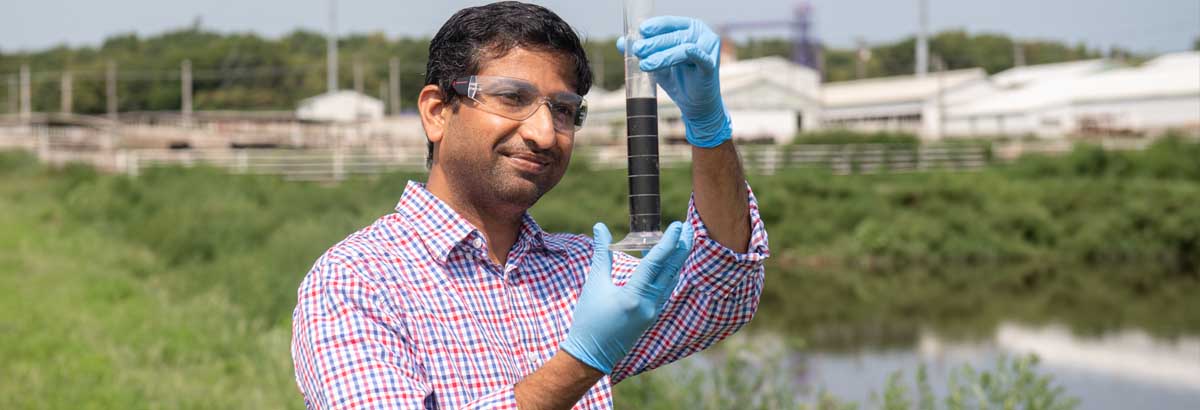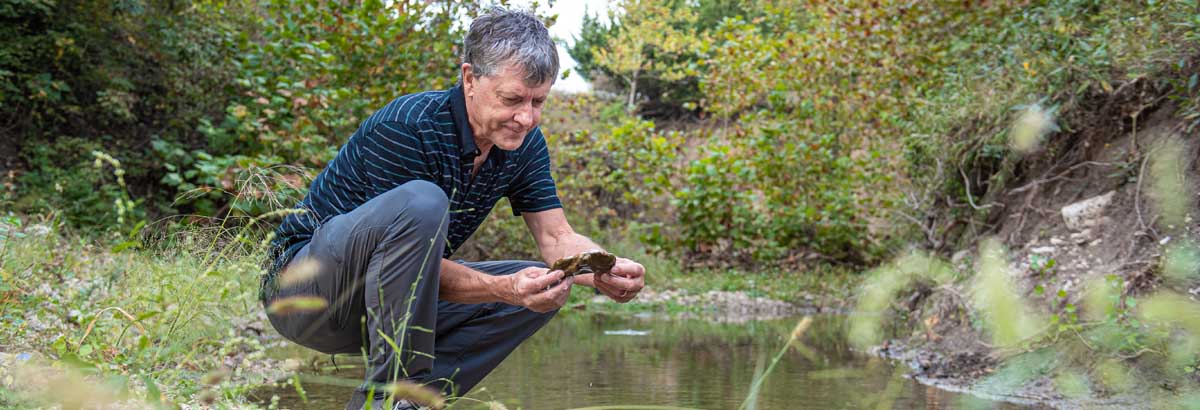Interdisciplinary teams study water to find solutions
Riding the wave
By Taylor Provine
Kansas State University researchers are diving in to find solutions to some of our biggest water problems.
It takes an interdisciplinary approach: The water research spans colleges and departments across the university. The work involves a variety of topics, too. Researchers want to understand water quantity and quality, to increase efficiency and to preserve one of our most precious natural resources.
K-State teams have garnered grants from federal agencies such as the Department of Energy, the Department of Agriculture, the Department of the Interior, NASA and the National Science Foundation. Read on to learn how K-State teams are engaged in interdisciplinary water research.

Misplaced resources
Achieving total resource recovery for animal wastewater through a new treatment technology and converting it into valuable resources is the focus of a project led by Prathap Parameswaran, associate professor and Fornelli engineering professorship designee in the Carl R. Ice College of Engineering civil engineering department.
“Typically, in the U.S. and in many other countries the primary focus has been on producing one product from wastewater treatment and that’s water,” Parameswaran said. “Now we are saying animal wastewater is not waste. It’s actually a misplaced resource. What kind of technology platforms do we need to recover it so it can be reused in the economy?”
Recovered products from animal wastewater could include methane-rich biogas, fertilizers, soil amendments or even organic acid precursors for plastics or chemicals, which are also essential for a society that relies so heavily on fossil fuels, Parameswaran said.
Parameswaran’s collaborators include Stacy Hutchinson, associate dean of the Office of Research and Graduate Programs in the college and professor in the Carl and Melinda Helwig Department of Biological and Agricultural Engineering; Lawrence Berkeley National Laboratory; the University of Pittsburgh; and the University of Kansas. The researchers are using $2 million from the U.S. Department of Energy Office of Energy Efficiency and Renewable Energy to merge Anaerobic Membrane Bioreactor, or AnMBR, technology and ecological, natural-based systems, such as wetlands.
AnMBR combines membrane technology with anaerobic biotechnology, meaning that the wastewater is treated in the absence of oxygen, which normally consumes a lot of energy. The researchers said wetlands can be used as a buffer during heavy rainfall events to further the water quality without overwhelming the system.
“Engineered systems are typically designed for optimal performance within a relatively narrow range of flow rate and concentration — making it more difficult to treat the variable animal waste,” Hutchinson said. “While natural systems are more flexible and can handle different flow rates and concentrations, they take a lot of space and time to treat high levels of waste. By merging both systems, we hope to optimize the best components of each system.”
Keeping freshwaters fresh
You’ve likely heard about it in the news, especially during the hot summer months when many families want to take a trip to the lake: blue-green algae.
Cyanobacteria, known as blue-green algae, can be toxic and harmful to people, pets and livestock. A blue-green algae outbreak, known as a bloom, can do more than ruin a day at the lake. In addition to the health risks, there are also economic impacts for surrounding areas because lakes must close to the public.
Trisha Moore, associate professor of biological and agricultural engineering, is studying water quality and what triggers blue-green algae outbreaks.
Moore is leading a project funded by the U.S. Department of the Interior U.S. Geological Survey to monitor and model cyanobacteria growth and bloom dynamics in water bodies in Kansas and New York.
“We’d like to advance our understanding to where we aren’t just reacting to it but that we can better predict and then also understand some better ways of treating it,” said Moore, also a Peggy and Gary Edwards Cornerstone teaching scholar. “For example, rather than relying on in-lake algaecides or treatments in our drinking water plants, we’d like to identify more holistic approaches to modify environmental conditions in the lake to reduce the frequency or severity of blooms.”
The team wants to go beyond the lake and understand what is going on in the surrounding landscape that might give the algae the nutrients or food needed to bloom and cause harmful outbreaks.
Moore is working with experts in algae dynamics and growth, water quality monitoring and process modeling, robotics and data science.
Unlocking water data in landlocked regions
Understanding how Earth’s total water storage is changing is a research focus of Jida Wang, associate professor of geography and geospatial sciences in the College of Arts and Sciences. Wang and collaborators are studying water loss in landlocked regions, which are boundaries that don’t have direct access to the ocean.
The team’s findings indicate that global landlocked regions have experienced a very substantial net water mass decline since the early 2000s.
“The declining rate is about 100 billion tons per year, so every year you are losing a total that is equivalent to four Great Salt Lakes in the global landlocked region, which is already dry,” Wang said. “The drying global landlocked basin means there are fewer water resources available for local people to consume and for ecological systems to sustain.”
Wang says the global water system is connected — landlocked or not.
“In theory, the decreasing water mass in a landlocked basin might be functioning as a potential source for sea level rise, which has a global impact,” Wang said. “That also gives people a perspective that we need to perhaps pay more attention to water conservation strategies and management of the dry regions.”
Wang’s team includes researchers from the NASA Jet Propulsion Laboratory at the California Institute of Technology; University of California at Los Angeles; the University of Grenoble Alpes and the Laboratory of Space Geophysical and Oceanographic Studies, or LEGOS, in France; and the Institute of Physical Geography at Goethe University and the Senckenberg Biodiversity and Climate Research Center in Germany.
Increasing the efficiency of water
Charles Rice, university distinguished professor of agronomy in the College of Agriculture, is leading a five-year, $10 million U.S. Department of Agriculture National Institute of Food and Agriculture collaborative study focused on improving water use efficiency and soil health for rainfed agriculture in dryland systems in the southern Great Plains.
“This region is particularly constrained because of the variable rainfall,” Rice said. “Some years or even within a season they get drought or too much water and also about 50% of the precipitation is lost due to nonproductive uses either through evaporation from the soil surface or transpiration through weeds.”
One goal of the project is to increase water and nitrogen use efficiencies by 50% and maintain or improve soil health.
“What we’re trying to do is intensify and diversify those systems,” Rice said. “In the years with more water, can we double-crop instead of having it bare over the summer? Another way to intensify and diversify is to add cover crops that could also be grazed to feed livestock.”
To achieve this, the team is applying different strategies to 17 different rotation systems in Kansas and Oklahoma. The researchers are adjusting the nitrogen/fertilizer rate: If it looks like it’s going to be a dry spring, less nitrogen is added; for a wet year, more nitrogen is added.
“If you have improved soil health, then water from intense rainstorms is infiltrating into the soil rather than running off the field and causing erosion,” Rice said. “That allows for the crops to use that water, increasing precipitation use efficiency.”
The researchers also are looking at weather forecasting to help project the probability of a wet or dry season, which could help farmers decide what crops to plant to lower their risk and stabilize their income.
“There are areas around the world that are similar to this region, so hopefully, we will not only have an impact in the central part of the U.S. but around the world and have a greater global impact,” Rice said.
The team involves the USDA Agricultural Research Service, Oklahoma State University and the University of Maryland and includes soil microbiologists, soil fertility experts, cropping system specialists, weed ecologists, modelers, economists and sociologists.

Mapping microbiomes of streams, soils and plants
If a person takes antibiotics it can sometimes disrupt the microbiome in the gut. Does the same thing happen when land use, pollution and climate change alter our plant and water systems?
Walter Dodds, university distinguished professor in the Division of Biology, is leading the Microbiomes of Aquatic, Plant and Soil Systems, or MAPS, program that studies how ecosystems are linked.
MAPS includes Dodds and a team of interdisciplinary researchers from the University of Kansas, Fort Hays State University and Wichita State University. The researchers are looking at how the microbes — which include bacteria and other organisms such as fungi — influence the way that the ecosystems work and the things they provide us.
The team is sampling soils and streams across Kansas for background factors such as nutrients and pH as well as the microbiomes themselves. They use advanced molecular and bioinformatics methods to characterize the tens of thousands of species in the microbiomes.
“The idea is that the systems are linked to each other, that things like plant productivity are mediated in part by the interactions with microbes,” Dodds said. “What happens in the soil is related to the microbes that are there and their interactions with the plants.”
The researchers have expanded their work to other related topics.
“We are also interested in learning how much pollution washes off cropland into the water, how much greenhouse gas is produced in the soils, how much carbon is stored there and how microbiomes mediate these processes,” Dodds said. “Then, once the materials get into the water, how that influences water quality. That includes toxic algal blooms and how they are related to the other aquatic microbes.”
River shapes and landscapes
Abigail Langston, assistant professor of geography and geospatial sciences, is researching the ways that rivers evolve. She is using a National Science Foundation Geomorphology and Land-use Dynamics Program grant to study the development of the Buffalo River in northwest Arkansas.
“Rivers shape landscapes by incising deep canyons and carving both wide and narrow valleys, determining where people live and where floodwaters go,” Langston said. “Little is known about how, when and why rivers carve wide versus narrow valleys as they flow through landscapes.”
Langston is working with a University of Arkansas collaborator and several graduate students to study controls on the development bedrock valleys on the Buffalo River — America’s first national river.
“Despite the intuitive idea that rivers create wide valleys in soft bedrock and narrow valleys in hard bedrock, my earlier research suggests that creating wide bedrock valleys is more complex than just the hardness or softness of the bedrock,” Langston said.
Understanding the how and why bedrock valleys widen will allow researchers, land-use planners and environmental scientists to interpret how river systems in the past, present and future have and will respond to changes in river sediment, Langston said.
The researchers also are engaging with teachers, K-12 students and Girl Scouts to develop an interactive mapping tool that highlights the intersection of the Buffalo River and the diverse people using the watershed.